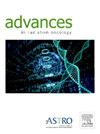脊柱不稳定性肿瘤评分作为脊柱转移放射治疗患者椎体骨折的预测指标:一项单机构研究
IF 2.7
Q3 ONCOLOGY
引用次数: 0
摘要
目的脊柱不稳定性肿瘤评分(SINS)是评估脊柱转移患者脊柱稳定性最常用的方法。我们试图评估(1)SINS评分作为椎体压缩性骨折(VCF)的预测因子,(2)6个SINS个体因素的风险贡献,以及(3)其他导致骨折风险的因素。方法和材料共纳入194例391例脊柱病变患者,这些患者以前未接受过椎体成形术/后凸成形术、放射治疗(RT)或手术治疗,并在RT前随访新的或恶化的骨折。结果187例治疗至361个椎体水平的患者接受了rt后随访。研究患者的平均随访时间为9.4个月(0.2-38.8个月)。共观察到33例新发或恶化骨折(9.1%),平均骨折时间为4.4个月(范围0.1-27.8个月)。在所有6个SINS因素中,发现有3个单独与骨折风险增加显著相关,它们是:病变位于L2-L4[危险比(HR) = 2.78, P = .04],计算机断层扫描上的混合或溶解性表现(混合HR = 3.87, P = .01,溶解性HR = 2.68, P = .02),和50%椎体塌陷(HR = 3.52, P <;. 01)。多变量分析显示,SINS作为总评分与骨折风险增加显著相关(P <;. 01)。在多变量分析中,在稳定(SINS≤6)和潜在不稳定(SINS, 7-12)病变(HR: 0.18, P = 0.03)中,使用双膦酸盐等骨强化药物也与骨折风险降低显著相关。结论:这些发现支持SINS是评估VCF风险的有用工具,病变位置、转移骨形态和50%塌陷是最强的预测因子。此外,研究结果表明,骨强化药物如双膦酸盐可能会降低RT后发生VCF的风险。本文章由计算机程序翻译,如有差异,请以英文原文为准。
Spinal Instability Neoplastic Score as a Predictor of Vertebral Fracture in Patients Undergoing Radiation Therapy for Spinal Metastases: A Single-Institution Study
Purpose
The Spinal Instability Neoplastic Score (SINS) is the most common method of assessing spine stability in the setting of spinal metastases. We sought to assess (1) the SINS score as a predictor of vertebral compression fracture (VCF), (2) the risk contributions of the 6 SINS individual factors, and (3) other contributors to fracture risk.
Methods and Materials
In total, 194 patients with 391 spinal lesions that had not previously been treated with vertebroplasty/kyphoplasty, radiation therapy (RT), or surgery were enrolled before RT and followed for new or worsened fracture.
Results
A total of 187 patients who were treated to 361 vertebral levels underwent post-RT follow-up. Average follow-up time for patients on study was 9.4 months (range, 0.2-38.8 months). A total of 33 new or worsened fractures (9.1% of lesions followed) were observed, with an average time to fracture of 4.4 months (range, 0.1-27.8 months). Of all 6 SINS factors, 3 were found to be individually significantly associated with increased risk of fracture, these were: lesion location in L2-L4 [hazard ratio (HR) = 2.78, P = .04], mixed or lytic appearance on computed tomography (mixed HR = 3.87, P = .01, lytic HR = 2.68, P = .02), and <50% vertebral collapse (HR = 3.52, P < .01). SINS as a summated score was significantly associated with increased risk of fracture on multivariable analysis (P < .01). Use of bone-strengthening medications such as bisphosphonates was also significantly associated with decreased risk of fracture in multivariable analysis in stable (SINS ≤6) (HR = 0.10, P = .03) and potentially unstable (SINS, 7-12) lesions (HR: 0.18, P = .03).
Conclusions
These findings support that SINS is a useful tool for estimating VCF risk, with lesion location, metastasis bone morphology, and presence of <50% collapse being the strongest predictors. Additionally, findings suggest that bone-strengthening medications such as bisphosphonates may mitigate the risk of developing VCF after RT.
求助全文
通过发布文献求助,成功后即可免费获取论文全文。
去求助
来源期刊

Advances in Radiation Oncology
Medicine-Radiology, Nuclear Medicine and Imaging
CiteScore
4.60
自引率
4.30%
发文量
208
审稿时长
98 days
期刊介绍:
The purpose of Advances is to provide information for clinicians who use radiation therapy by publishing: Clinical trial reports and reanalyses. Basic science original reports. Manuscripts examining health services research, comparative and cost effectiveness research, and systematic reviews. Case reports documenting unusual problems and solutions. High quality multi and single institutional series, as well as other novel retrospective hypothesis generating series. Timely critical reviews on important topics in radiation oncology, such as side effects. Articles reporting the natural history of disease and patterns of failure, particularly as they relate to treatment volume delineation. Articles on safety and quality in radiation therapy. Essays on clinical experience. Articles on practice transformation in radiation oncology, in particular: Aspects of health policy that may impact the future practice of radiation oncology. How information technology, such as data analytics and systems innovations, will change radiation oncology practice. Articles on imaging as they relate to radiation therapy treatment.
 求助内容:
求助内容: 应助结果提醒方式:
应助结果提醒方式:


